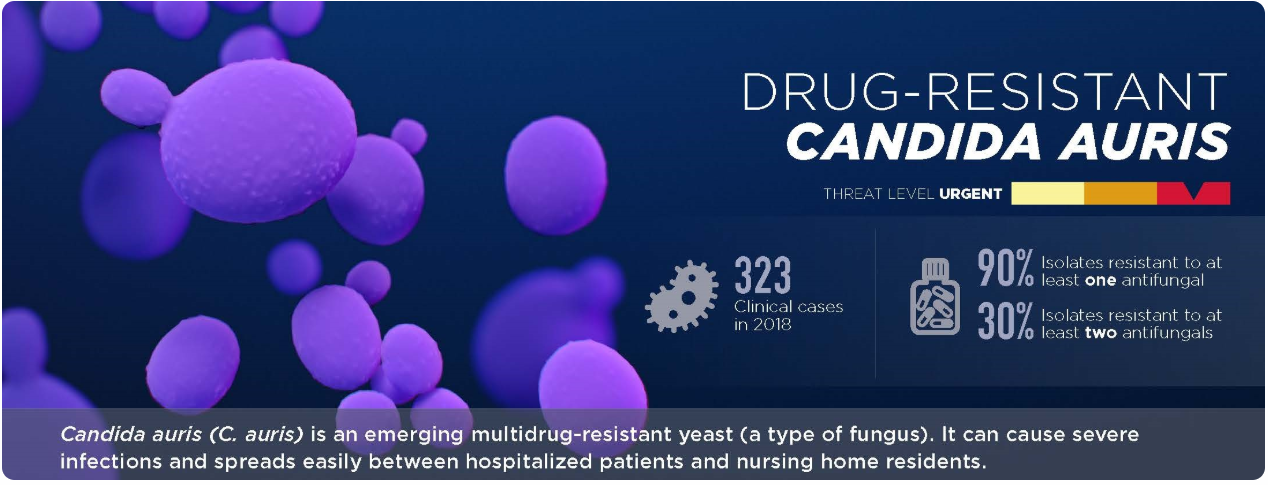What is Candida auris and why is it important?
Candida auris (C. auris) is an emerging fungus that presents a serious global health threat. C. auris is resistant to many of the antifungal drugs commonly used to treat infections. C. auris can cause many different types of infection, such as bloodstream, wound, urinary tract, and ear. Invasive C. auris infections have been associated with 30-60% mortality rates among hospitalized patients. Most deaths have occurred in persons with other serious illnesses that increased the risk of death. C. auris is a public health concern due to its potential for multi-drug resistance, ability to spread in healthcare settings, and rapid appearance in many parts of the United States. Click here to see the latest national information from the Centers for Disease Control and Prevention (CDC). C. auris infections have also been reported in dozens of other countries. Outbreaks of this organism have occurred in healthcare settings, so early identification and communication about cases are essential to awareness and prevention.
Individuals can carry C. auris and may not have any symptoms. These individuals are often already admitted to a healthcare facility with another serious illness or condition and often have risk factors such as mechanical ventilation, tracheostomy, invasive medical devices, and frequent healthcare encounters. Persistence of C. auris in both the environment and prolonged skin colonization on patients enables its spread within healthcare facilities. CDC recommends consultation with an infectious disease physician for patients with C. auris infection. In cases identified from noninvasive sites, CDC does not recommend treatment.
 Source: CDC
Source: CDC
What should be done if Candida auris is identified?
If your laboratory or health care facility has identified a patient with Candida auris, please notify the Candida auris Epidemiologist at the Indiana State Department of Health at (317) 232-7814.
For laboratory identification or isolate submission questions, please contact IDOHL Antimicrobial Resistance Supervisor at (317) 921-5820.
You can find additional C. auris reporting forms and toolkits in the Resources section at the bottom of the page.
Candida auris Surveillance and Infection Control Recommendations
Strict adherence to infection control activities is an effective method to prevent the spread of C. auris, regardless of the source of the specimen. It is critical to perform correct environmental cleaning and disinfection to eliminate transmission and exposure risk. Some disinfectants commonly used in healthcare settings are not effective against C. auris. Click here to see the EPA’s registered antimicrobial products effective against C. auris. Click here for CDC guidance on infection control activities for C. auris.
Screening and proper identification is an important part of C. auris infection control practices. C. auris can be difficult to identify when using standard laboratory testing methods. Laboratory professionals are advised that C. auris can be misidentified as other yeasts when using common microbiological methods. No phenotypic characteristics easily distinguish C. auris from other Candida species. The most reliable way to identify C. auris is MALDI-TOF MS. If MALDI-TOF MS not available, PCR may be an alternative method for C. auris idenitification. You can see here if the yeast identification method used in your laboratory misidentifies C. auris.
The IDOH Laboratories can rule-out C. auris and C. auris look-alike clinical isolates using MALDI-TOF MS. The IDOH Laboratories has advised that species-level identification for C. auris occurs in the following situations:
- All C. auris isolates. New clinical isolates of C. auris from previously identified patients should still be sent to IDOHL for confirmation and subsequent antifungal susceptibility testing.
- Clinical isolates of unusual Candida spp. (species other than C. albicans, C. parapsilosis, C. dubliniensis, C. lusitaniae, C. tropicalis or C. krusei).
- Clinical isolates that fit the criteria of an unusual Candida spp., as defined above, do not need to be submitted if the identifying laboratory uses matrix-assisted laser desorption ionization time of flight (MALDI-TOF) for speciation and confirmation of Candida spp.
- Isolates not identified beyond Candida spp. from invasive infections.
- Non-sterile source isolates that are refractory to azole therapy which were either not identified or identified only as ‘not Candida albicans’.
For further epidemiologic information please contact the Candida auris Epidemiologist.
Page last reviewed and updated: September 2025

